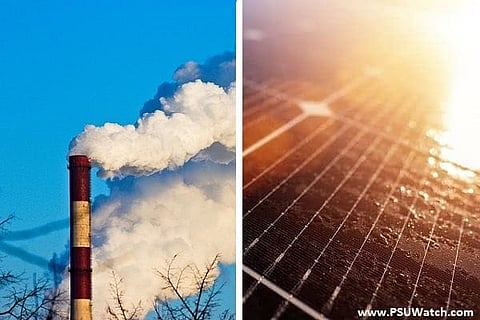
- News Updates
- PSU Watch
- Defence News
- Policy Watch
- हिन्दी न्यूज़
- Jobs Watch
- States News
- Event News

New Delhi: India has plans to replace 58,000 MU of thermal power with 30 GW of Renewable Energy (RE) by 2025-26 by making use of the bundling scheme. The Ministry of Power has recently unveiled a trajectory for the replacement of thermal power under which it is planning to operate thermal power plants at the technical minimum of 40 percent and supplement it with RE under the tariff policy for bundling of RE with thermal energy. "Accordingly, in order to increase the uptake of Renewable Energy utilisation under the scheme and in furtherance of the national goal of achieving 500 GW of non-fossil fuel-based capacity by 2030, a target of about 58,000 MU is fixed at national level for achievement by end of the year 2025-26," the ministry has said in an order dated May 26. An RE capacity of 30 GW (at 22 percent capacity utilisation factor) would be required to replace 58,000 MU of thermal power in Central, state-owned and private TPPs.
The government has said that India will operate thermal power plants at the technical minimum of 40 percent in order to accommodate cheaper renewable energy. Power from TPPs with high tariffs is proposed to be replaced first under the scheme. "The existing regulations of CERC define a technical minimum of 55 percent up to which Thermal Power Plants (TPPs) in the country can be operated. Reduction in generation from TPPs is feasible up to lower levels of technical minimum of 40 percent in 2 to 3 years," said the ministry.
India is planning to replace 20 percent of thermal power by FY2024, 35 percent by FY2025 and 45 percent by FY2026
"The TPPs in future shall operate up to the technical minimum to accommodate cheaper Renewable Energy when it is available. Thermal energy from those TPPs with high tariffs is proposed to be replaced so as to optimise the costs of power delivered to the consumer," the Ministry of Power has said.
According to the roadmap prepared by the Ministry of Power, India is planning to replace 20 percent of thermal power by FY2024, 35 percent by FY2025 and 45 percent by FY2026. Sector-wise, the government wants Central TPPs to replace 33,260 MU with 17.25 GW of RE, state-run TPPs to replace 12,386 MU with 6.42 GW of green energy and private sector power plants to replace 12,224 MU of thermal power with 6.34 GW of RE.
Referring to the current coal crisis, the government has said that substitution of thermal power with RE power will alleviate the concerns of coal crisis and enable the country in meeting the maximum power demand while benefitting consumers. "The replacement of thermal power will save a good amount of coal annually consumed in the country leading to reduced emissions greening of the environment. The implementation of the scheme is estimated to conserve 34.7 MMT of coal and reduce Carbon emissions by 60.2 MMT," it added.
A thermal generating station can substitute larger amounts of thermal power with RE power over and above the targets fixed by the ministry. And hydro generating stations can also bundle RE power along with hydro power to take part in the scheme, the ministry has said.
"The generating stations that have installed or procured a higher capacity for the purpose of replacement of power but not getting scheduled are free to sell such power in the power exchange," the government has said.
"All the generating stations and the states are directed to implement the above to reduce their tariffs, meet their RPO commitments, increase utilisation of transmission lines and reduce emissions," it added.
(PSU Watch– India's Business News centre that places the spotlight on PSUs, Bureaucracy, Defence and Public Policy is now on Google News. Click here to follow. Also, join PSU Watch Channel in your Telegram. You may also follow us on Twitter here and stay updated.)
